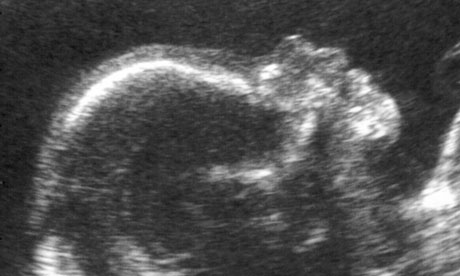
Women who terminate their pregnancies after a diagnosis of foetal anomaly should not be forced to go through labour to deliver their dead babies, a conference will hear on Monday.
Because NHS hospitals now mostly refuse to offer surgical operations under anaesthetic in such cases, women are being denied choice, according to Jane Fisher, director of Antenatal Results and Choices (Arc), a charity supporting families where a fetal anomaly is suspected.
Of the 800,000 women who become pregnant in the UK each year, 35,000 will be told their unborn child is at risk, although fewer than 4,000 will have a serious problem diagnosed in their unborn child. For those women, however, the trauma is often compounded by the stark prospect of having to go into an induced labour.
At a London conference, organised by Arc and the British Pregnancy Advisory Service, the charity will call for the health secretary to address the issue and will attack the "politicisation" of abortion.
"Ending a wanted pregnancy after a diagnosis of foetal anomaly is extremely distressing for women and their partners," said Fisher. "At such a difficult time our research tells us that it is important that women are given the space and time to decide on the termination method that they can best cope with.
"Our experience is that there are too many women who are horrified to learn labour is the only way to end the pregnancy and not nearly enough who are actually given a choice, or even told that there is an option. To be honest, a major issue is that abortion is coming increasingly into the independent sector and a lot of the surgical expertise has followed it, leaving a lot of doctors who lack the appetite for surgical procedures. While there persists a myth that labour is safer, actually the risks in the two options are comparable."
Fisher said Arc was not promoting one method over another, but just wanted women to be given a choice.
Terminations carried out because of foetal anomaly are authorised under ground E of the Abortion Act, and account for just over 1% of all abortions. Statistics released this year reveal a significant disparity between the proportion carried out by surgery authorised under ground E, and the proportion of surgical abortions in general.
For ground E abortions conducted under 13 weeks' gestation, 55% are surgical and 45% induced. But the woman's pregnancy progresses, she is less likely to have a surgical termination. They account for only 20% of terminations performed for fetal anomaly at 15-16 weeks; 10% at 17-18 weeks; and 1% at 20-21 weeks.
This is in marked contrast to other abortions, where over three quarters at between 10 and 20 weeks are surgical, reflecting the fact that many women prefer not to have to go through the experience of labour when ending their pregnancy.
Kate, 40, (not her real name), found herself having to terminate a much-wanted pregnancy when chromosome disorders were diagnosed. She borrowed £1,000 to pay for and have a surgical abortion, after being told when she was 13 weeks pregnant that she would have to wait another two weeks just to see a consultant at her local hospital and that she would be expected to give birth.
She said: "I feel it would have haunted me even worse than the whole situation already does. Delivering a baby who was dead, I had two healthy children and I wanted the experience of labour to be a positive one. I don't think I would have dared to go ahead and try to have another baby if I had had to go through labour for my lost baby. I know one woman who was told a surgical procedure would damage her cervix, which is not true. There's loads of people who seem to think that after 13 weeks you have to deliver your baby, that's just not true."

